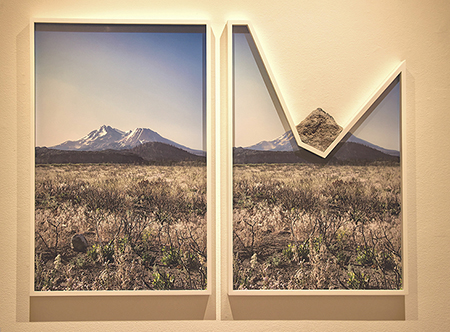
Continuing Through October 21, 2023
I want to doubt landscape, but also remain true to the awe and fascination that it evokes.
— Richard T. Walker
In Caspar David Friedrich’s Romantic 1818 painting, “Wanderer Above the Sea of Fog,” a young frock-coated hiker pauses atop a mountain peak to meditate on the spectacle of the wooded landscape below him, half-submerged in cloud. How do contemporary artists who no longer believe in the divinity of landscape, the sublime, and even aesthetic epiphanies, engage with the evergreen theme in the anthropocentric era with its global climate change disasters?
Many artists address the issue with overtly polemical work, while others choose to present the paradoxical beauty as the price of progress, trusting viewers to see and act accordingly; yet others, including various land and conceptual artists, go to nature to practice their art without preconditions, with a more philosophic or experimental attitude, bringing their findings back to the studio and then to that contemporary aerie of aesthetic contemplation, the art gallery. All approaches are permissible, of course, in the marketplace of aesthetic ideas.
British-born artist Richard T. Walker, a longtime resident of the Bay Area, continues to interrogate nature and the solitary observer, through multimedia works in photography. sculpture, video, performance and music. In the tradition of recent land and conceptual artists, Walker brings back fragments of Northern California landscapes, which he embeds in hybrid artworks with notations and associated representations in drawing, photography, audio and video, so that the viewer becomes a vicarious ambler, following in the observant artist’s wide-ranging tracks. The playfully ironic title, “Never Here /Always There,” conveys the flavor of Walker’s inquiries and investigations, a far cry from the crystalline Ansel Adams ethos recently on display at the deYoung Museum, and closer to the sardonic 1960s maxim, wherever you go, there you are.
The dichotomy between reality and representation has gone from a burning to a still smoldering issue in recent years. Mimesis was a dirty word, associated as it was with ruling-class propaganda. That particular aesthetic battle has subsided, and artists are free again to work and play with imagery without fear of a tastemaker Taliban. Richard T. Walker’s color photographs of photogenic, unspoiled wilderness avoid the picturesque though his heterodox cropping and framing into eccentric polygonal forms, kind of a thought as it defers to its past future self. Walker juxtaposes his pentagonal photos with bronze castings of branches found at the photo sites, as well as pentagonal photographs mounted behind at a distance. The approach makes for artworks that cannot be seen completely — except sequentially — and thus are remembered piecemeal rather than as a whole.
In two pieces from a 2023 series entitled “eternally almost,” Walker aligns photographs of a lone tree at a Crater Lake shore in Oregon with ink line drawings made by his father, a veteran illustrator living in England’s Lake Country, of another tree photographed at Lake Shasta in the far north of California. In the diptych photo landscape, “this, as it isn’t (mountain #2)” (2022), the artist alters the shape of the frame on the right so that it appears to have been crushed downward and inward. Resting in the V space at the top of the frame is a triangular rock taken from the site that exactly fits the contours of the mountaintop cropped out. It’s a clever update of Magritte’s games of illusion and obscured reality.
More complicated are “a form of endlessness” (also 2022), with four photos of mountaintops cropped and framed so as to suggest a snowcapped geode or meteor suspended with a faceted framework, a floating summit; and “the infinity of an infinite distance” (2023), a combination of polygonal photos, rocks, neon tubing and electrical wire that suggests a bobbing bird, or oil pump. Of particular interest to Bay Area viewers is “what we were (as we were)” (2023), a scattered array of large color photos from San Francisco’s McLaren Park taken during the wildfire season of 2020. Each orange-skied panel houses a speaker that occasionally plays a guitar chord. A video projection from 2023, “anywhere, somewhere (multiple),” was filmed at the shore near Pigeon Point Lighthouse, with a drum set placed on the rocky shore, struck at random by an occasional piece of flung driftwood. A humorous metaphor for human futility, or a celebration of our short, miraculous existence?
